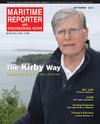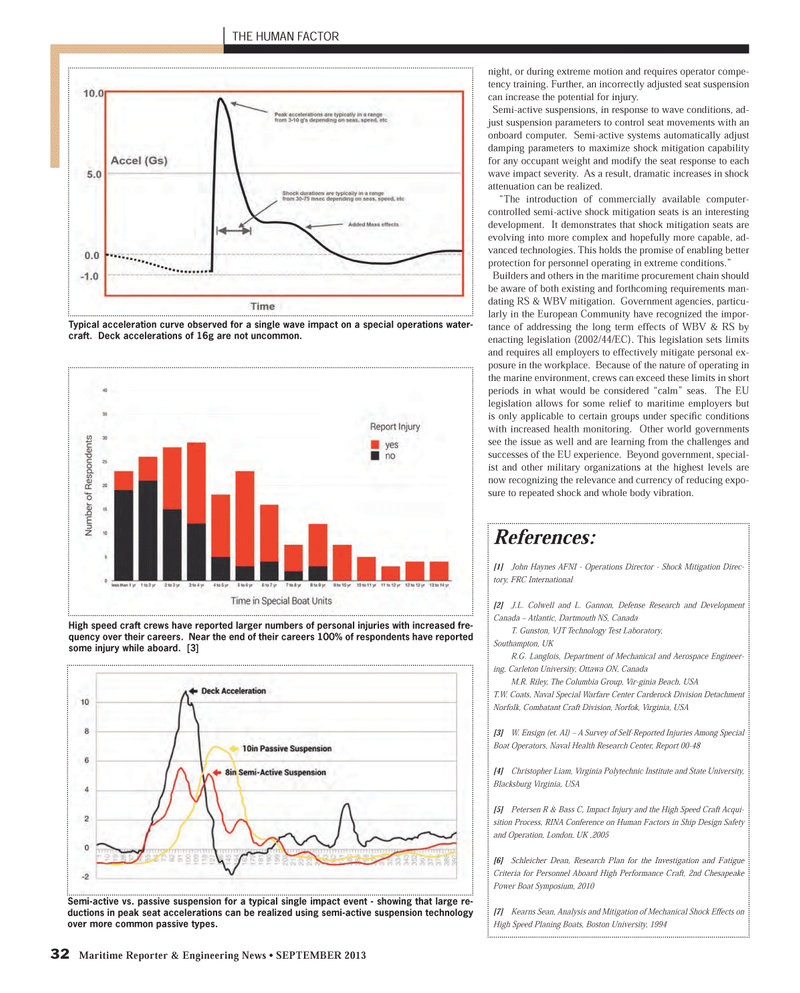
Page 32: of Maritime Reporter Magazine (September 2013)
Workboat Annual
Read this page in Pdf, Flash or Html5 edition of September 2013 Maritime Reporter Magazine
32 Maritime Reporter & Engineering News ? SEPTEMBER 2013 night, or during extreme motion and requires operator compe-tency training. Further, an incorrectly adjusted seat suspension can increase the potential for injury. Semi-active suspensions, in response to wave conditions, ad-just suspension parameters to control seat movements with an onboard computer. Semi-active systems automatically adjust damping parameters to maximize shock mitigation capability for any occupant weight and modify the seat response to each wave impact severity. As a result, dramatic increases in shock attenuation can be realized. ?The introduction of commercially available computer- controlled semi-active shock mitigation seats is an interesting development. It demonstrates that shock mitigation seats are evolving into more complex and hopefully more capable, ad-vanced technologies. This holds the promise of enabling better protection for personnel operating in extreme conditions.?Builders and others in the maritime procurement chain should be aware of both existing and forthcoming requirements man-dating RS & WBV mitigation. Government agencies, particu- larly in the European Community have recognized the impor- tance of addressing the long term effects of WBV & RS by enacting legislation (2002/44/EC). This legislation sets limits and requires all employers to effectively mitigate personal ex- posure in the workplace. Because of the nature of operating in the marine environment, crews can exceed these limits in short periods in what would be considered ?calm? seas. The EU legislation allows for some relief to maritime employers but is only applicable to certain groups under speciÞ c conditions with increased health monitoring. Other world governments see the issue as well and are learning from the challenges and successes of the EU experience. Beyond government, special-ist and other military organizations at the highest levels are now recognizing the relevance and currency of reducing expo-sure to repeated shock and whole body vibration. THE HUMAN FACTOR Typical acceleration curve observed for a single wave impact on a special operations water- craft. Deck accelerations of 16g are not uncommon. High speed craft crews have reported larger numbers of personal injuries with increased fre- quency over their careers. Near the end of their careers 100% of respondents have reported some injury while aboard. [3] Semi-active vs. passive suspension for a typical single impact event - showing that large re- ductions in peak seat accelerations can be realized using semi-active suspension technology over more common passive types. References:[1] John Haynes AFNI - Operations Director - Shock Mitigation Direc- tory, FRC International [2] J.L. Colwell and L. Gannon, Defense Research and Development Canada ? Atlantic, Dartmouth NS, Canada T. Gunston, VJT Technology Test Laboratory, Southampton, UK R.G. Langlois, Department of Mechanical and Aerospace Engineer- ing, Carleton University, Ottawa ON, Canada M.R. Riley, The Columbia Group, Vir-ginia Beach, USA T.W. Coats, Naval Special Warfare Center Carderock Division Detachment Norfolk, Combatant Craft Division, Norfok, Virginia, USA [3] W. Ensign (et. Al) ? A Survey of Self-Reported Injuries Among Special Boat Operators, Naval Health Research Center, Report 00-48 [4] Christopher Liam, Virginia Polytechnic Institute and State University, Blacksburg Virginia, USA [5] Petersen R & Bass C, Impact Injury and the High Speed Craft Acqui- sition Process, RINA Conference on Human Factors in Ship Design Safety and Operation, London, UK ,2005[6] Schleicher Dean, Research Plan for the Investigation and Fatigue Criteria for Personnel Aboard High Performance Craft, 2nd Chesapeake Power Boat Symposium, 2010[7] Kearns Sean, Analysis and Mitigation of Mechanical Shock Effects on High Speed Planing Boats, Boston University, 1994 MR #9 (26-33).indd 32MR #9 (26-33).indd 329/3/2013 10:14:16 AM9/3/2013 10:14:16 AM

 31
31

 33
33
